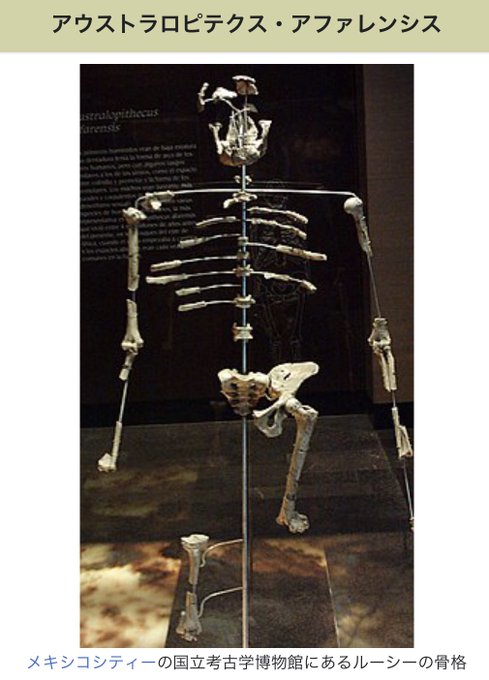australopithecusのTwitterイラスト検索結果。 58 件中 2ページ目
アウストラロピテクス
アファレンシス(Australopithecus-afarensis)
370万~300万年前医療
医者は要らず
ワクチン、薬は要らず
知能、科学は要らず
空気、地球、太陽は必要
生まれる
動く
子孫を残す(現人類に至るまで)
死ぬ
The distal femur of an early #hominin like Australopithecus africanus is among the most humanlike parts of their anatomy. The angulation between the femoral shaft and condyles reflects habitual bipedal gait. #paleoanthropology
Australopithecus anamensis is the earliest known #hominin of its genus. Its diet seems to have concentrated on woodland foods more than the later Au. afarensis or Au. africanus, within a habitat with mixed trees and C4 grasses. #paleoanthropology
The discovery of the MLD 18 #hominin mandible in 1953 followed the sorting and movement of more than 5000 tons of miners' dump material. The fossil comes from one of the older adult individuals known for Australopithecus africanus. #paleoanthropology
The MH2 #hominin mandible is still being built, fragment by fragment, as pieces are recovered from Malapa and prepared in the lab. The skull of this adult Australopithecus sediba individual may be found within the breccia as well. #paleoanthropology
As the smallest mandible in the highly variable Sterkfontein Member 4 #hominin sample, Stw 404 has been a key fossil in understanding whether all these fossils represent Australopithecus africanus, or some of them may represent a second, larger species. #paleoanthropology
The AL 400-1 #hominin jaw was chewed by a carnivore before it was fossilized 3.3 million years ago. This individual is attributed to Australopithecus afarensis. #paleoanthropology
Estimates of the age of fossil #hominin children have come a long way in 50 years. Still, we have much to learn about the variation in enamel growth rates in some species, including Australopithecus afarensis. The LH 2 child died at around 3.25 years of age. #paleoanthropology
Reconstrucción del cráneo de Australopithecus anamensis (MRD-VP-1/1 de 3,8 Ma, con maxilar KNM-KP 29283 y mandíbula KNM-KP 29281 de 4,2 Ma). Fuente: https://t.co/Iijlp3JtwS
By the late 1950s, scientists had recovered #hominin fossils that showed that Australopithecus and Paranthropus were bipeds in a humanlike pattern. The pelvis evolved a form different from any other living or fossil primates. #paleoanthropology
Three million years ago, Lucy (Australopithecus afarensis) shared the landscape with three species of giraffes, two of rhinos, a hippo, and four elephant-like creatures—all now extinct. What happened to them? https://t.co/tUZjzkfwKi #fossils
The new Australopithecus anamensis cranium: does it fit well into the “tree”? (English version below) https://t.co/wS7NvPpIG4 via @robertosaezm
The AL 333 locality at Hadar is a striking assemblage of at least 13 #hominin individuals attributed to Australopithecus afarensis, including at least 4 children. How these individuals came to rest together is still not known, taphonomy rules out a flash flood. #paleoanthropology
One of the branches of the #hominin tree can be traced today as far as 4.1 million years ago, at Kanapoi, Kenya. Here, the track becomes unclear. What was the origin of the Australopithecus line, and how does it connect to fossils like Ardipithecus? #paleoanthropology
Some fossil #hominin skulls have an important place in understanding the variation of extinct species. Stw 505 is a large Australopithecus africanus skull, helping to show that big individuals had brains that overlapped in size with the larger-brained Homo. #paleoanthropology
Could Australopithecus have been the first hominin genus to migrate out of Africa? We haven't found them in Eurasia yet, but this specimen from Chad suggests that they were widespread far from the East African rift and South African caves. #hominin #paleoanthropology
Fossils of Australopithecus and Homo were all obligate bipeds, but their pelvic remains do exhibit some differences. Australopithecus sediba blurs the boundary. With its Homo-like pelvis, this species may be a closer human relative. #hominin #paleoanthropology
A pesar del pequeño volumen craneal de Homo naledi, comparable al de Australopithecus, rasgos de su estructura son innovaciones comunes con otras especies de Homo.
Endocast morphology of Homo naledi from the Dinaledi Chamber, South Africa. https://t.co/lHZg70fCdq
Día 9 del #PaleoInktober2020, toca el mayor reto para mí: homínidos.
Tras muchos borrones, me decidí por Lucy, la Australopithecus afarensis, portando un bebé.
Su nombre se debe a la canción "Lucy in the Sky with Diamonds" de The Beatles.
#inktoberpaleo2020
#inktober2020
#sculptober
Day - 4 Prehistoric
Australopithecus afarensis































